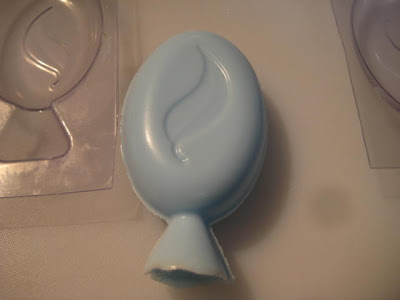
The Finished Product! A 3-D Oval Bar with leaf imprint. A perfect mold for making "Soap on the Rope".
 We have a tutorial posted on our web site for using this 3-D Mold Market mold. It's a tutorial worthy of revisiting as this mold produces an outstanding, professional looking soap. Once the mold is cut into two pieces, it's a piece of cake to make this soap. The prep work is in cutting the mold. I used scissors to cut around the mold cavities and a small hand hacksaw to cut the opening for the pouring channel (you can purchase a small hacksaw at places like Home Depot or Lowes). It took me about 5 minutes to prep the mold.
We have a tutorial posted on our web site for using this 3-D Mold Market mold. It's a tutorial worthy of revisiting as this mold produces an outstanding, professional looking soap. Once the mold is cut into two pieces, it's a piece of cake to make this soap. The prep work is in cutting the mold. I used scissors to cut around the mold cavities and a small hand hacksaw to cut the opening for the pouring channel (you can purchase a small hacksaw at places like Home Depot or Lowes). It took me about 5 minutes to prep the mold.
 Align the two halves and secure with either our soap clips, or binder clips. I elected to use binder clips this time just to see how well they worked. For the record, they worked like a charm. Position your mold in an upright position and slowly pour your soap base into the mold channel. I poured at around 135 degrees. There was little or no seepage around the edges of the mold when pouring at that temperature.
Align the two halves and secure with either our soap clips, or binder clips. I elected to use binder clips this time just to see how well they worked. For the record, they worked like a charm. Position your mold in an upright position and slowly pour your soap base into the mold channel. I poured at around 135 degrees. There was little or no seepage around the edges of the mold when pouring at that temperature.
 Allow the soap to set-up until firm and then remove soap clips. Gently pull apart the mold halves allowing air to come between the mold and soap. Once that happens, the two halves will separate very easily.
Allow the soap to set-up until firm and then remove soap clips. Gently pull apart the mold halves allowing air to come between the mold and soap. Once that happens, the two halves will separate very easily.

Using a kitchen knife or paring knife (not a table knife, you need something relatively sharp) trim any excess soap from around the edges. A vegetable peeler will also work for the trimming the edges. Cut off and trim the pour spout. And there you have it, a 3-D soap bar. You can easily add some cording to create a "soap on the rope". After pouring the soap into the mold, insert a piece of cording (fold the cord in half to make a loop) and insert into the mold. Use a mold or binder clip to keep the cording from sinking into the mold. Cording can be purchased at fabric stores. Cut the cord to desired length and then use a lighter to singe the ends (so they don't fray).
 The Finished Product! A 3-D Oval Bar with leaf imprint. A perfect mold for making "Soap on the Rope".
The Finished Product! A 3-D Oval Bar with leaf imprint. A perfect mold for making "Soap on the Rope".


 Using a kitchen knife or paring knife (not a table knife, you need something relatively sharp) trim any excess soap from around the edges. A vegetable peeler will also work for the trimming the edges. Cut off and trim the pour spout. And there you have it, a 3-D soap bar. You can easily add some cording to create a "soap on the rope". After pouring the soap into the mold, insert a piece of cording (fold the cord in half to make a loop) and insert into the mold. Use a mold or binder clip to keep the cording from sinking into the mold. Cording can be purchased at fabric stores. Cut the cord to desired length and then use a lighter to singe the ends (so they don't fray).
Using a kitchen knife or paring knife (not a table knife, you need something relatively sharp) trim any excess soap from around the edges. A vegetable peeler will also work for the trimming the edges. Cut off and trim the pour spout. And there you have it, a 3-D soap bar. You can easily add some cording to create a "soap on the rope". After pouring the soap into the mold, insert a piece of cording (fold the cord in half to make a loop) and insert into the mold. Use a mold or binder clip to keep the cording from sinking into the mold. Cording can be purchased at fabric stores. Cut the cord to desired length and then use a lighter to singe the ends (so they don't fray).
No comments:
Post a Comment